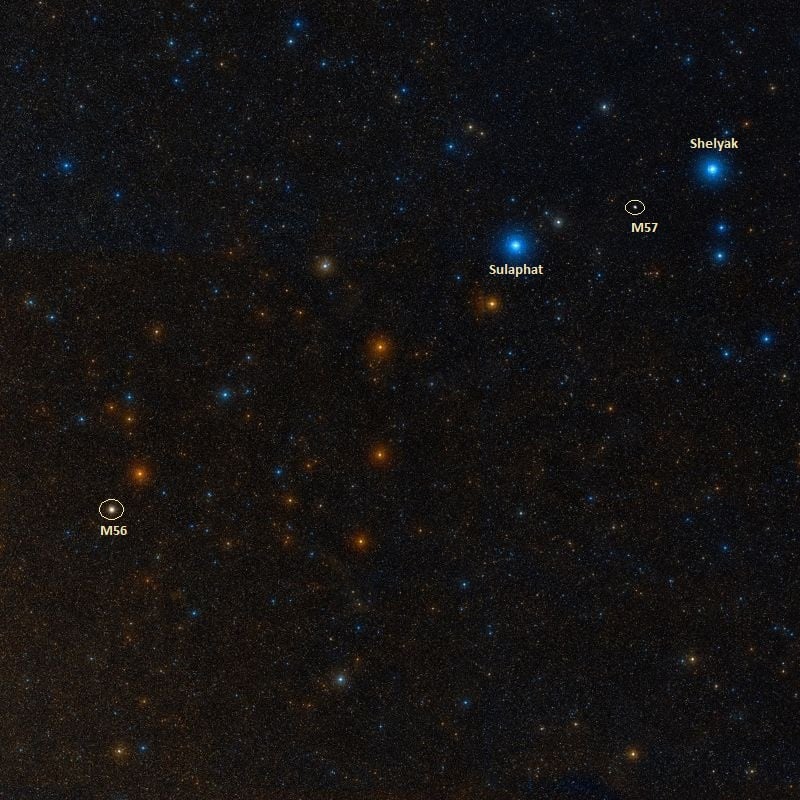Welcome back to Messier Monday! We continue our tribute to our dear friend, Tammy Plotner, by looking at the the globular star cluster known as Messier 56. Enjoy!
In the 18th century, while searching the night sky for comets, French astronomer Charles Messier kept noting the presence of fixed, diffuse objects in the night sky. In time, he would come to compile a list of approximately 100 of these objects, with the purpose of making sure that astronomers did not mistake them for comets. However, this list – known as the
Messier Catalog
– would go on to serve a more important function.
One of these objects is Messier 56, a globular star cluster located in the small northern constellation of
Lyra
, roughly 32,900 light years from Earth. Measuring roughly 84 light-years in diameter, this cluster has an estimated age of 13.70 billion years. It is also relatively easy to spot because of its proximity to well-known asterisms like the celestial
Swan
, the
Northern Cross
, and the bright star
Vega
.
Description:
Spanning about 85 light years in diameter, this incredible ball of stars is moving towards planet Earth at a speed of 145 kilometers per second... yet still remains about 32,900 light-years away. As one of the less dense of the Milky Way's halo globulars, it is also less dense in variable stars - containing only perhaps a dozen. But out of that twelve, there a very special one... a Cepheid bright enough to be followed with amateur instruments. However, astronomers never stopped looking for the curious - and they found what they were looking for!
[caption id="attachment_137128" align="aligncenter" width="567"]
NASA/ESA Hubble image of the globular star cluster known as Messier 56. Credit: NASA/ESA/HST/Gilles Chapdelaine
[/caption]
The CURiuos Variables Experiment (CURVE) was performed on M56 in 2008. As P. Pietrukowicz (et al) wrote of the cluster in the
accompanying study
:
But could other things exist inside M56? Events, perhaps, like nova? As astronomer Tim O'Brien
wrote
:
And as M.E.L. Hopwood (et al.) wrote in a
2000 study
:
[caption id="attachment_137127" align="aligncenter" width="580"]
Globular cluster Messier 56 in Lyra. Credit: Wikipedia Commons/Hewholooks[/caption]
History of Observation:
Charles Messier first discovered M56 on January 23rd, 1779. As he wrote of his discovery at the time:
However, it would be Sir William Herschel who revealed its true nature in 1807. In his private notes he writes: "The 56th of the Connoiss. is a globular cluster of very compressed and very small stars. They are gradually more compressed towards the centre." His son John would go on to observe it many times, even after cataloging it! His best description reads: "Large; round; very gradually brighter toward the middle. I see the stars which are very small and of different sizes. It fades gradually away to the borders."
As always, it would be Admiral Smyth who would be perhaps a bit more descriptive when he included in his observing notes:
[caption id="attachment_137126" align="aligncenter" width="580"]
Messier 56 location. Credit: IAU/Sky & Telescope magazine (Roger Sinnott & Rick Fienberg)
[/caption]
Locating Messier 56:
Finding M56 isn't too hard since it's located about half-way between Beta Cygni (Albireo) and Gamma Lyrae. In both binoculars and finder scope, you will see a triangle of stars when progressing from Gamma towards the southeast that will almost point directly at it! Because M56 isn't particularly large or bright, it does require dark skies - but makes a great object for both binoculars and small telescopes.
Enjoy this pincushion of stars! And here are the quick facts on this Messier Object to help you get started"
- Object Name
-
Messier 56
- Alternative Designations
-
M56, NGC 6779
- Object Type
-
Class X Globular Cluster
- Constellation
-
Lyra
- Right Ascension
-
19 : 16.6 (h:m)
- Declination
-
+30 : 11 (deg:m)
- Distance
-
32.9 (kly)
- Visual Brightness
-
8.3 (mag)
- Apparent Dimension
-
8.8 (arc min)
We have written many interesting articles about Messier Objects here at Universe Today. Here's Tammy Plotner's
Introduction to the Messier Objects
,
M1 – The Crab Nebula
, and David Dickison's articles on the
2013
and
2014
Messier Marathons.
Be to sure to check out our complete
Messier Catalog
. And for more information, check out the
SEDS Messier Database
.
Sources:
- *Messier Objects – Messier 56*
- SEDS – Messier 56
- Wikipedia – Messier 56
 Universe Today
Universe Today
